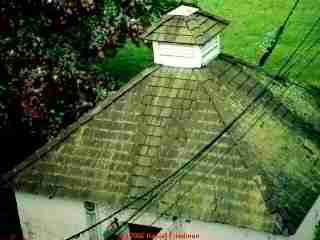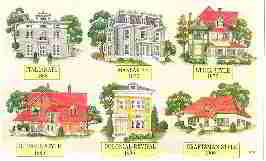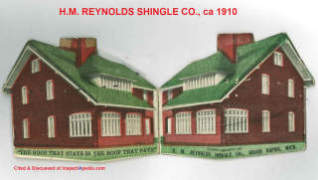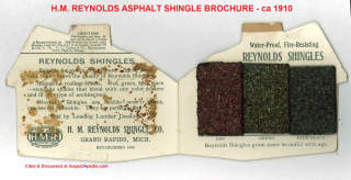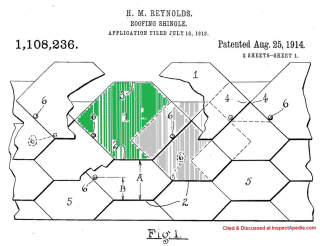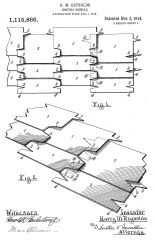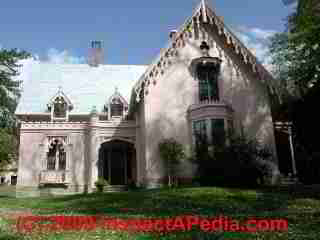 Guide to Roof Age, Style, & Choices of Roofing Materials
Guide to Roof Age, Style, & Choices of Roofing Materials
Determinng the Age of a Building
- POST a QUESTION or COMMENT about how to estimate building age from its roofing architectural style and materials
Roof age & architectural style guide: Here we provide a photo guide and a series of detailed descriptive articles that offer guidance in determining the age of a building and its roof by examination of the choices of roofing materials as well as the building roof architectural style.
The age of a building or its individual components can sometimes be determined quite accurately by documentation, but when documents are not readily available, visual clues such as those available during a professional home inspection can still determine when a house was built by examining its components, building materials, even nails, fasteners, and types of saw cuts on lumber.
InspectAPedia tolerates no conflicts of interest. We have no relationship with advertisers, products, or services discussed at this website.
- Daniel Friedman, Publisher/Editor/Author - See WHO ARE WE?
Roofing Materials as Indicators of Building Age
Wood shingle roofing has been in use for hundreds of years in the U.S. and Europe.
But an inspection of interior and exterior roofing details can indicate the probable age of a wood roof (which can last up to 40 years) as well as the roofing history of the building, the number and types of roofing layers, and related house-age-determination details.
The wood shingle roof shown in the photo below is on a building in Key West, Florida,
adjacent to the Hemingway house, viewed from the Key West tower. Notice the absence of lichens on the
wood shingles in the roof area below the metal-flashed rooftop tower?
We discuss here various roofing materials (Wood, slate, asphalt shingles (in several generations),
clay tile, metal roofing (several styles and generations), and how they assist in finding The age of a building below.
History and Dates of Use of Various Roofing Materials
This article explains the eras of use of different types of roofing materials as an aid to understanding the history and age of buildings
If you are trying to determine the age and condition of a particular roof covering, please see AGE OF ROOFING.
If you need to see a complete index to articles describing all types of building roofing materials & methods
see ROOFING INSPECTION & REPAIR
- Asbestos Cement Roofing & more recently, Fiber Cement Roofing: see
- ASBESTOS & FIBER CEMENT ROOFING
- ASBESTOS CEMENT CORRUGATED ROOFING
- FIBERBOARD ROOFING & FIBER-WOOD ROOFING where we discuss wood fiber roofing such as Masonite™ products
- Asphalt roofing shingles: see
- Asphalt roll roofing:
See ROLL ROOFING, ASPHALT & SBS
- BUILT UP ROOFS - multi-ply membrane roofing, including tar and gravel roofs, have a life expectancy of about 5 years per ply.
- CLAY TILE ROOFING
- MASONITE WOODRUF FIBERBOARD ROOFING
- METAL ROOFING
- MODIFIED BITUMEN ROOFING
- MODIFIED BITUMEN ROOFING FAQs
- Rubber and synthetic roof coverings:
See MEMBRANE & SINGLE PLY ROOFS - SLATE ROOF INSPECTION & REPAIR
- SOD ROOFING & GREEN ROOFS
- STONE ROOFING
- THATCH ROOFING
- WOOD SHAKE & SHINGLE ROOFING
Cement Board & Fiber Cement Roofing Products
Exterior Siding & Roofing Using Asbestos Cement included asbestos cement shingles, asbestos cement siding, corrugated asbestos-cement roofing.
See
Other fiber cement materials used in construction included
- TRANSITE PIPE AIR DUCT ASBESTOS RISKS
- TRANSITE PIPE CHIMNEYS & FLUES
- TRANSITE PIPE WATER SUPPLY PIPING
Also see
Modern Cement Board & Fiber Cement Products
Cement board is a non-structural building sheathing material which in its contemporary form is made from Portland cement covered with a reinforced fiberglass mesh fabric. Cement board is used as a tile backer or a backer board for stucco applications on buildings. Current producers include Custom Building Products (WonderBoard™) and US Gypsum (Durock™).
Panels made of a mixture of cement and wood fibers are produced for building siding by James Hardi (Hardi-panel and Cemplank™), and CertainTeed (Weatherboard™).
Clues to building age include
these examples which we expand and detail in text and articles below.
Visual clues pointed out by a home inspector or available to any careful building inspector can help indicate the age of a building.
In addition to examining the roofing material, a look at roof framing, lumber marks, even types of fasteners all can relate the roof age to the building age and give information about both. More examples of this approach to identifying building architectural style, roof style, roof age and building age are in these articles:
- Architectural style, decorations, trim, building components - our introductory material is
at ARCHITECTURE, STYLE, & BUILDING AGE.
For detailed guides, see the articles and text organized
at ARCHITECTURE & BUILDING COMPONENT ID
and see - NAILS, AGE & HISTORY Construction fasteners, nails, screws, the use of treenails or pegs in post and beam framing, and fasteners such as roofing nails and screws used, hardware: window and door hardware, hinges, doorknobs, door pulls, latches
- ROOFING MATERIALS, AGE, TYPES, asphalt shingles, stone roofs, slate roofs, tile roofs, wood shingle and shake roofs, built up roofing ("tar and gravel roofs"), modified bitumen roofs, EPDM and other membrane roof coverings
- SAW & AXE CUTS, TOOL MARKS, AGE, hand hewn adze marks or even the type of saw cut marks on framing lumber
Keep in mind that even when we can identify specific types of building materials and building methods, precise dating of the time of construction of a building remains difficult: old building materials were often re-used, so beams, siding, and other components may appear in a building built later than when the materials were first made.
Also, in the U.S. various states had machines for making cut nails, screws, and sawmills at different times. For example, New York State was industrialized earlier than some western or southern states, so machine-made nails appear earlier in New York than elsewhere.
Historic Roofing Materials & Roof Age
History and Dates of Use of Various Roofing Materials
Familiarity with roofing materials used on historic buildings and with the history of manufacture of roofing materials can help determine the age of a building as well as the more practical question of age of and remaining life of a roof.
This article series explains the eras of use of different types of roofing materials as an aid to understanding the history and age of buildings.
The oldest roofing materials, in use since prehistoric times were stone or stone slabs, and slate. From Roman times clay roof tiles were widely-used and remain in-use today as a durable roof material.
You will read in the Reynolds shingle patents below that when shifting from the more-rigid traditional roof shingles of wood and their heavier brothers slate, stone, or clay tiles to a lighter and more-flexible asphalt roof shingle, the inventors had to cope with the problems of wind-uplift and durability that could accompany a flexible roof covering.
Early History of Asphalt Roof Shingles & the H.M. Reynolds Shingle Company
Harry M. Reynolds was one of the early if not earliest producer of asphalt shingles in the U.S.
Image above: H.M. Reynolds Shingle Co., showing green colored asphalt shingle roof in a 1910 catalog, retrieved 2021/08/05, original source: https://archive.org/details/HMReynoldsShingleCo
H.M. Reynolds was established in Grand Rapids, Michigan, U.S., in 1868. The image below shows that the company's shngles were approved by the Board of Fire Underwriters (for fire resistance), and were available in red, green, and blue-black.
Remarkably the little advertising flyer shown above includes a note that this H.M. Reyolds paper and asphalt-shingle-sample brouchure could be folded together and blown-throug to play a tune or to make a noise like a parrot or rooster! The flyer's patent gives it an earliest-possible date of April 1909.
Above Harry M. Reynolds 1914 asphalt shingle patent for hexagonal shingle shapes; we added colors to illustrate the shingle side-lap pattern.
- Reynolds, Harry M. ROOFING SHINGLE [PDF] U.S. Patent 1,108,236, issued August 25, 1914.
This patent is for the company's invention of the widely-used hexagonal-shaped asphalt shingle that the patent described as:
The object of the invention is to provide a shingle of such shape and so secured that when laid upon a roof it will avoid the fore going objections and to this end the nails by which it is attached will be located nearer the loose edge of the shingle than is possible with the ordinary form, and also the exposed portions of the shingle provided with obtuse angles thus stiffening that portion and preventing warping of the same;
to provide shingles which will not form an opening between adjacent edges of the same and permit the weather to beat through the roof; to provide shingles which when laid will present a pleasing appearance,
and to provide the same with certain new and use ful features hereinafter more fully described and particularly pointed out in the claims, reference being had to the accompanying drawings, ...
- Reynolds, Harry M. ROOFING SHINGLE [PDF] U.S. Patent 1,115,866, issued November 3, 1914. This is an interlocking shingle of a different pattern, as you may read in the PDF.
Excerpts:
My invention relates to improvements in roofing shingles, and more particularly to shingles made of a fabric composed mainly of felt and asphalt. Heretofore such shin gles have been made in the form of a rec tangular parallelogram and laid in Sub stantially the same manner as the ordinary wooden shingles, that is, side by side with the lower portion of each shingle exposed to the weather and with nothing to hold them down in place at the lower end, being secured only by fastenings, such as nails, driven through the same beneath the next course above.
Shingles so laid must necessarily be quite rigid in order to stay in place, the action of the weather and wind having a tendency to raise their lower corners which are held only by the rigidity of the shingle itself, consequently shingles of this kind are required to be made of con siderable thickness and rigidity and contain more material than would otherwise be nec essary to avoid this tendency.
The object of my invention is to provide such shingles with certain novel features and particularly with means whereby the lower edges or lower ends of the shingles will be securely held down.
My invention comprises shingles of substantially rectangular form provided with recesses or indentations in their sides near their lower edges, whereby when these shin gles are laid the edge of each adjacent shin gle is inserted in said notch or recess and the lower corner of the shingle having this recess extends beneath the adjacent shingle.
This secures the lower corners of each shingle in place and adequately prevents the same from warping up or being loosened by the wind and weather at the lower edge. - Dupont, Henry H. ROOFING [PDF] U.S. Patent 1,201,811, issued October 17, 1916.
Excerpt: This invention relates to a roofing con struction in which shingles made of plastic material are used in conjunction with a novel substructure to form an imitation of terra cotta tile roofing. - Herbert, Abraham. INTERLOCKING SHINGLE [PDF] U.S. Patent 1,410,867, issued March 28, 1922.
- Asphalt roll roofing: ROLL ROOFING, ASPHALT & SBS
- BUILT UP ROOFS
- CLAY TILE ROOFING - home
- CONCRETE ROOFING
- CORRUGATED ROOFING
- EPDM, RUBBER, PVC ROOFING
- FIBER CEMENT ROOFING - home
- FIBERBOARD ROOFING & FIBER-WOOD ROOFING
- FlintKote ROOFING CATALOG [PDF], The Flintkote Company, 50 W. 50th St., New York N.Y. a survey of roofing materials and other building materials produced by the company.
FlintKote, founded in 1901, incorporated in 1917, produced asbestos-cement siding and shingles (ca 1930), roofing materials, insulation, insulating board, and other building products in the United States until 1987.
The company's products included cement-asbestos siding, possibly some roof products that contained asbestos, and ThermalKote, a water-resistant coating that contained asbestos and that was marketed until 1981. After forming an asbestos trust fund the company filed for bankruptcy in 2004 and was reorganized in 2015. - HISTORIC ROOFING MATERIALS [PDF], National Park Service, "From Asbestos to Zinc, Roofing for Historic Buildings", U.S. National Park Servic
- MASONITE WOODRUF FIBERBOARD ROOFING
- METAL ROOFING - home
- MEMBRANE & SINGLE PLY ROOFS
- MODIFIED BITUMEN ROOFING
- ROLL ROOFING, ASPHALT & SBS
- ROOFING MATERIALS, AGE, TYPES, asphalt shingles, stone roofs, slate roofs, tile roofs, wood shingle and shake roofs, built up roofing ("tar and gravel roofs"), modified bitumen roofs, EPDM and other membrane roof coverings
- RUBBER, EPDM, PVC ROOFING
- RUBBER ROOF SHINGLES & SLATES
- SBS ROOFING ROLL & BUR ROOFS
- SLATE ROOF INSPECTION & REPAIR
- SOD ROOFING & GREEN ROOFS
- STONE ROOFING
- THATCH ROOFING
- Wilson, Richa, and Kathleen Snodgrass, EARLY 20TH-CENTURY BUILDING MATERIALS: SIDING AND ROOFING, (2008) [PDF] USDA Forest Service, Richa Wilson, Intermountain Regional Architectural Historian Kathleen Snodgrass, Project Leader, USDA Forest Service, Missoula Technology and Development Center 5785 Hwy. 10 West Missoula, MT 59808–9361 Phone: 406–329–3978 Fax: 406–329–3719 E-mail: wo_mtdc_pubs@fs.fed.us
- WOOD SHAKE & SHINGLE ROOFING
...
Continue reading at ROOF LEAK DIAGNOSIS & REPAIR or select a topic from the closely-related articles below, or see the complete ARTICLE INDEX.
Or see these
Recommended Articles
- AGE of a BUILDING, HOW to DETERMINE
- ASPHALT SHINGLE LIFE / WEAR FACTORS
- EARLY ROOF FAILURE DIAGNOSTIC QUESTIONS
- HAIL DAMAGED ROOFS
- ROOF ARCHITECTURAL STYLES
- ROOF LEAK DIAGNOSIS & REPAIR
- ROOFING MATERIAL AGE vs BUILDING AGE
- WARRANTIES for ROOF SHINGLES
Suggested citation for this web page
ROOFING MATERIALS, AGE, TYPES at InspectApedia.com - online encyclopedia of building & environmental inspection, testing, diagnosis, repair, & problem prevention advice.
Or see this
INDEX to RELATED ARTICLES: ARTICLE INDEX to BUILDING ARCHITECTURE
Or use the SEARCH BOX found below to Ask a Question or Search InspectApedia
Or see
INDEX to RELATED ARTICLES: ARTICLE INDEX to BUILDING DAMAGE, DISASTER, REPAIRS
Or use the SEARCH BOX found below to Ask a Question or Search InspectApedia
Ask a Question or Search InspectApedia
Try the search box just below, or if you prefer, post a question or comment in the Comments box below and we will respond promptly.
Search the InspectApedia website
Note: appearance of your Comment below may be delayed: if your comment contains an image, photograph, web link, or text that looks to the software as if it might be a web link, your posting will appear after it has been approved by a moderator. Apologies for the delay.
Only one image can be added per comment but you can post as many comments, and therefore images, as you like.
You will not receive a notification when a response to your question has been posted.
Please bookmark this page to make it easy for you to check back for our response.
IF above you see "Comment Form is loading comments..." then COMMENT BOX - countable.ca / bawkbox.com IS NOT WORKING.
In any case you are welcome to send an email directly to us at InspectApedia.com at editor@inspectApedia.com
We'll reply to you directly. Please help us help you by noting, in your email, the URL of the InspectApedia page where you wanted to comment.
Citations & References
In addition to any citations in the article above, a full list is available on request.
- Mark Cramer Inspection Services Mark Cramer, Tampa Florida, Mr. Cramer is a past president of ASHI, the American Society of Home Inspectors and is a Florida home inspector and home inspection educator. Mr. Cramer serves on the ASHI Home Inspection Standards. Contact Mark Cramer at: 727-595-4211 mark@BestTampaInspector.com
- John Cranor [Website: /www.house-whisperer.com ] is an ASHI member and a home inspector (The House Whisperer) is located in Glen Allen, VA 23060. He is also a contributor to InspectApedia.com in several technical areas such as plumbing and appliances (dryer vents). Contact Mr. Cranor at 804-873-8534 or by Email: johncranor@verizon.net
- Thanks to reader Kathy Bohon for suggesting using various sources of public records to determine the age of a home, 7/30/2009.
- Carson Dunlop, Associates, Toronto, have provided us with (and we recommend) Carson Dunlop Weldon & Associates'Technical Reference Guide to manufacturer's model and serial number information for heating and cooling equipment ($69.00 U.S.). Technical Reference Guide, Carson Dunlop Weldon & Associates, Ltd., 120 Carlton St. Suite 407, Toronto, Ontario, M5A 4K2 Canada, ISBN 1-895585-90-2 165pp.
- America's Favorite Homes, mail-order catalogues as a guide to popular early 20th-century houses, Robert Schweitzer, Michael W.R. Davis, 1990, Wayne State University Press ISBN 0814320066 (may be available from Wayne State University Press)
- American Plywood Association, APA, "Portland Manufacturing Company, No. 1, a series of monographs on the history of plywood manufacturing",Plywood Pioneers Association, 31 March, 1967, www.apawood.org
- Asbestos products and their history and use in various building materials such as asphalt and vinyl flooring includes discussion which draws on ASBESTOS, ITS INDUSTRIAL APPLICATIONS, ROSATO 1959, D.V. Rosato, engineering consultant, Newton, MA, Reinhold Publishing, 1959 Library of Congress Catalog Card No.: 59-12535 (out of print).
- Building Research Council, BRC, nee Small Homes Council, SHC, School of Architecture, University of Illinois at Urbana-Champaign, brc.arch.uiuc.edu. "The Small Homes Council (our original name) was organized in 1944 during the war at the request of the President of the University of Illinois to consider the role of the university in meeting the demand for housing in the United States. Soldiers would be coming home after the war and would be needing good low-cost housing. ... In 1993, the Council became part of the School of Architecture, and since then has been known as the School of Architecture-Building Research Council. ... The Council's researchers answered many critical questions that would affect the quality of the nation's housing stock.
- How could homes be designed and built more efficiently?
- What kinds of construction and production techniques worked well and which did not?
- How did people use different kinds of spaces in their homes?
- What roles did community planning, zoning, and interior design play in how neighborhoods worked?
- "An Example of Colonial Paneling", Norman Morrison Isham, The Metropolitan Museum of Art Bulletin, Vol. 6, No. 5 (May, 1911), pp. 112-116, available by JSTOR.
- Manufactured & Modular Homes: Modular Building Systems Association, MBSA, modularhousing.com, is a trade association promoting and providing links to contact modular builders in North America. Also see the Manufactured Home Owners Association, MHOAA, at www.mhoaa.us. The Manufactured Home Owners Association of America is a National Organization dedicated to the protection of the rights of all people living in Manufactured Housing in the United States.
- Plank House Construction: weblog from plankhouse.wordpress.com/2009/01/25/plank-house-construction/ and where plank houses were built by native Americans, see
Large 1:6 Scale Plank House Construction / P8094228, Photographer: Mike Meuser
06/12/2007 documented at yurokplankhouse.com where scale model Museum quality Yurok Plank Houses are being sold to raise money for the Blue Creek Ah Pah Traditional Yurok Village project, Web: bluecreekahpah.org/ - Scott C. LeMarr has provided his file of keys to decode Furnace and Water Heater Age from the data provided on the manufacturer's equipment labels. Mr. LeMarr is a professional home inspector, Certified Professional Inspector/President, MASTER Indoor Environmental Specialist (MIES). Vice President of Wisconsin NACHI. He and his company, Honest Home Inspections [ Website: www.HonestHomeInspections.com ], LLC. can be reached at 262-424-5587 or by email to scott@honesthomeinspections.com
- What Style Is It?: A Guide to American Architecture, Rev., John C. Poppeliers, S. Allen Chambers, Wiley; Rev Sub edition (October 6, 2003), ISBN-10: 0471250368, ISBN-13: 978-0471250364
- Our recommended books about building & mechanical systems design, inspection, problem diagnosis, and repair, and about indoor environment and IAQ testing, diagnosis, and cleanup are at the InspectAPedia Bookstore. Also see our Book Reviews - InspectAPedia.
- Best Practices Guide to Residential Construction, by Steven Bliss. John Wiley & Sons, 2006. ISBN-10: 0471648361, ISBN-13: 978-0471648369, Hardcover: 320 pages, available from Amazon.com and also Wiley.com. See our book review of this publication.
- Decks and Porches, the JLC Guide to, Best Practices for Outdoor Spaces, Steve Bliss (Editor), The Journal of Light Construction, Williston VT, 2010 ISBN 10: 1-928580-42-4, ISBN 13: 978-1-928580-42-3, available from Amazon.com
- The Journal of Light Construction has generously given reprint permission to InspectAPedia.com for this article. All rights and contents are ©Journal of Light Construction and may not be reproduced in any form.
- Asphalt Roofing Residential Manual from ARMA the Asphalt Roofing Manufacturers Association Website https://www.asphaltroofing.org/product/residential-asphalt-roofing-manual/ ,
- Building Pathology, Deterioration, Diagnostics, and Intervention, Samuel Y. Harris, P.E., AIA, Esq., ISBN 0-471-33172-4, John Wiley & Sons, 2001 [General building science-DF] ISBN-10: 0471331724 ISBN-13: 978-0471331728
- Building Pathology: Principles and Practice, David Watt, Wiley-Blackwell; 2 edition (March 7, 2008) ISBN-10: 1405161035 ISBN-13: 978-1405161039
- Concrete Folded Plate Roofs, C. Wilby PhD BSc CEng FICE FIStructE (Author), Butterworth-Heinemann, 1998, ISBN-10: 0340662662, ISBN-13: 978-0340662663
- Concrete Shell Roofs, C. Wilby PhD BSc CEng FICE FIStructE (Author),
- Concrete Dome Roofs (Longman Concrete Design and Construction Series),
- Green Roof Plants: A Resource and Planting Guide, Edmund C. Snodgrass, Lucie L. Snodgrass, Timber Press, Incorporated, 2006, ISBN-10: 0881927872, ISBN-13: 978-0881927870. The text covers moisture needs, heat tolerance, hardiness, bloom color, foliage characteristics, and height of 350 species and cultivars.
- Green Roof Construction and Maintenance, Kelley Luckett, McGraw-Hill Professional, 2009, ISBN-10: 007160880X, ISBN-13: 978-0071608800, quoting: Key questions to ask at each stage of the green building process Tested tips and techniques for successful structural design Construction methods for new and existing buildings Information on insulation, drainage, detailing, irrigation, and plant selection Details on optimal soil formulation Illustrations featuring various stages of construction Best practices for green roof maintenance A survey of environmental benefits, including evapo-transpiration, storm-water management, habitat restoration, and improvement of air quality Tips on the LEED design and certification process Considerations for assessing return on investment Color photographs of successfully installed green roofs Useful checklists, tables, and charts
- Handbook of Building Crafts in Conservation, Jack Bower, Ed., Van Nostrand Reinhold Company, NY 1981 ISBN 0-442-2135-3 Library of Congress Catalog Card Nr. 81-50643.
- Historic Preservation Technology: A Primer, Robert A. Young, Wiley (March 21, 2008) ISBN-10: 0471788368 ISBN-13: 978-0471788362
- Historic Slate Roofs : With How-to Info and Specifications, Tina Skinner (Ed), Schiffer Publishing, 2008, ISBN-10: 0764330012 , ISBN-13: 978-0764330018
- Low Slope Roofing, Manual of, 4th Ed., C.W. Griffin, Richard Fricklas,
McGraw-Hill Professional; 4 edition, 2006, ISBN-10: 007145828X, ISBN-13: 978-0071458283
- Roof failure causes in depth (and specific methods for avoiding them)
- Roof design fundamentals and flourishes, based on voluminous industry research and experience
- New technologies and materials -- using them safely and correctly
- Comprehensive coverage of all major roofing systems pecifications, inspection, and maintenance tools for roofing work
- Metal Roofing, an Illustrated Guide, R.A. Knowlton , [metal shingle roofs],
- Problems in Roofing Design, B. Harrison McCampbell, Butterworth Heineman, 1991 ISBN 0-7506-9162-X (available used)
- Roofing The Right Way, Steven Bolt, McGraw-Hill Professional; 3rd Ed (1996), ISBN-10: 0070066507, ISBN-13: 978-0070066502
- Slate Roofs, National Slate Association, 1926, reprinted 1977 by Vermont Structural Slate Co., Inc., Fair Haven, VT 05743, 802-265-4933/34. (We recommend this book if you can find it. It has gone in and out of print on occasion.)
- The Slate Roof Bible, Joseph Jenkins, www.jenkinsslate.com, 143 Forest Lane, PO Box 607, Grove City, PA 16127 - 866-641-7141 (We recommend this book).
- Slate Roofing in Canada (Studi4es in archaeology, architecture, and history),
- Smart Guide: Roofing: Step-by-Step Projects, Creative Homeowner (Ed), 2004, ISBN-10: 1580111491, ISBN-13: 978-1580111492
- Tile Roofs of Alfred: A Clay Tradition in Alfred NY
- WEATHER RESISTIVE BARRIERS [PDF] U.S. Department of Energy, ", how to select and install housewrap and other types of weather resistive barriers
- Wood Shingle Roofs, Care and Maintenance of wood shingle and shake roofs, (EC), Stanley S. Niemiec (out of print)
- In addition to citations & references found in this article, see the research citations given at the end of the related articles found at our suggested
CONTINUE READING or RECOMMENDED ARTICLES.
- Carson, Dunlop & Associates Ltd., 120 Carlton Street Suite 407, Toronto ON M5A 4K2. Tel: (416) 964-9415 1-800-268-7070 Email: info@carsondunlop.com. Alan Carson is a past president of ASHI, the American Society of Home Inspectors.
Thanks to Alan Carson and Bob Dunlop, for permission for InspectAPedia to use text excerpts from The HOME REFERENCE BOOK - the Encyclopedia of Homes and to use illustrations from The ILLUSTRATED HOME .
Carson Dunlop Associates provides extensive home inspection education and report writing material. In gratitude we provide links to tsome Carson Dunlop Associates products and services.


